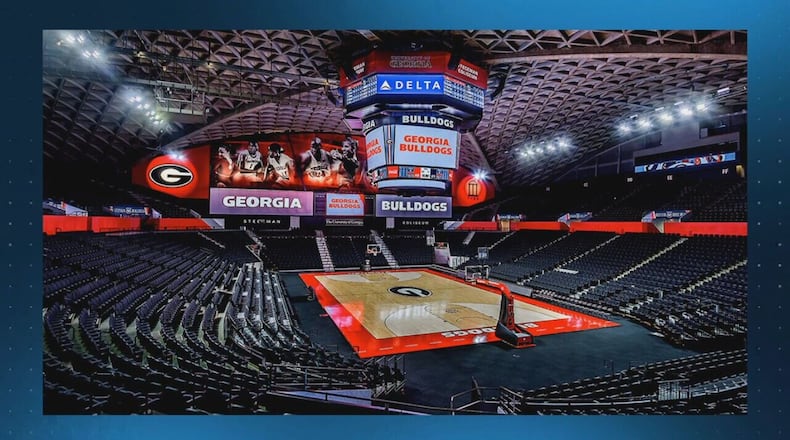ATHENS — Stegeman Coliseum is expected to be open for business in time for basketball games in the fall, but there is a lot of work to be done before then.
That’s according to several people with knowledge of the situation, who spoke with The Atlanta Journal-Constitution on the condition of anonymity. According to them, engineers are closing in on a solution for flaking concrete, which has been falling from the ceiling of the 60-year-old facility in increasing amounts for the past several years.
At the moment, Stegeman Coliseum is closed. It has been shut down since March 2, one day after a “palm-sized” piece of concrete was discovered to have fallen dozens of feet from the ceiling into a spectator area of the 10,523-seat arena. A gymnastics meet scheduled two days later was postponed and moved to Gwinnett County. Since then, every event scheduled at the facility through May has been moved to alternate locations, including several commencement ceremonies.
As of this week, only engineers and construction workers are permitted in the building, which is owned by the university and not the UGA Athletic Association. A special entry point has been created so that Georgia coaches whose teams compete in the arena can walk in to show recruits the building.
What they see now is multiple truckloads of scaffolding erected over the seating areas and a humongous boom lift machine in the middle of the floor. All that equipment has been transported to the facility so that the ceiling and roof-supporting structures can be inspected by engineers.
In 2018, UGA contracted with the Atlanta engineering firm of Wiss, Janney, Elstner (WJE) to do periodic inspections of the ceiling and roof. That group has executed those inspections twice a year, utilizing drones and in-person examinations. Maintenance has been performed regularly.
Earlier this year, the university sought a second opinion from the structural engineering firm of Walter P. Moore. Coincidentally, their engineers happened to be scheduled to be on-site the day of the latest debris fall.
What engineers have found is evidence of delamination and spalling occurring between the triangle panels of concrete that were set together to form the iconic roof of the coliseum. Between moisture seeping in, expansion and contraction that occurs because of exterior heating and cooling and the natural sway of wind and earth movement, some of the expansion joints between those panels have incurred minor damage from rubbing together. Those issues are in the process of being repaired.
However, it has been determined that there is no structural damage. In other words, there is no danger of the arched roof falling in. UGA has yet to share the engineers’ reports but is expected to soon.
Meanwhile, engineers are closing in on a permanent solution to occasional flaking cement. Among the considerations is some sort of soft protective barrier that would be spread across the interior of the ceiling over the spectator occupied areas.
What apparently is not going to happen is UGA using an alternative facility to host its sporting events. UGA officials met with members of the Classic City Authority to discuss the possibility of utilizing the new Classic City Arena in Athens as a basketball and gymnastics venue. The city-owned building is under construction but is expected to be completed by this fall. But between UGA wanting more seating and parking and the city wanting a lot of money, officials could not agree to terms.
For now, at least, UGA also is not considering building a new arena. Construction cost estimates for a 10,000-seat facility exceed $200 million. State Board of Regents policy requires that 50% of projected costs for any major construction project be pledged through fundraising.
About the Author
Keep Reading
The Latest
Featured


